Llyn Gwyn – Fishing in the land of the Monks
In Wales we are blessed with hundreds of natural lakes or llynneod as we call them, which offer a quality fishing experience for those seeking sport in magnificent surroundings. However, most of them hold wild brown trout only and therefore cannot be fished in the winter months.
There is however an exception; Llyn Gwyn near Rhayader. Run by the local angling club as a stocked trout fishery, this attractive natural venue is open all year on a day ticket basis.
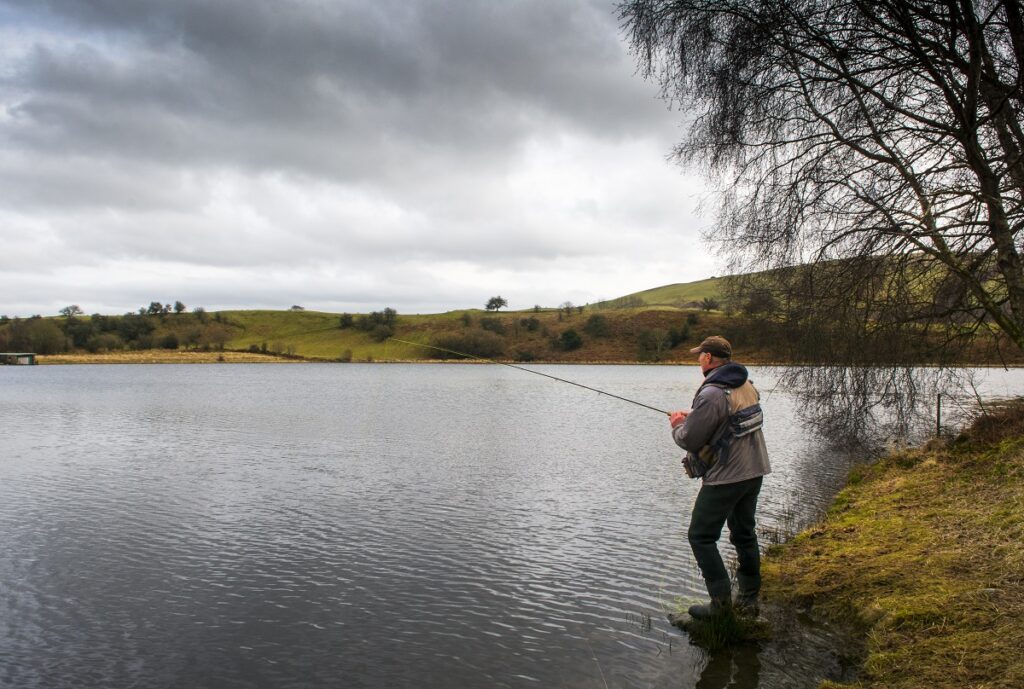
The White lake, a place of legends
Literally translated from Welsh as ‘the white lake’ llyn Gwyn has several local legends associated with it. One says that it is the entrance to the otherworld realm of the ‘fair folk’ King, Gwyn Ap Nudd, a fearsome Celtic warrior who features in Arthurian mythology. Another says that St Patrick passed by while on a pilgrimage from Ireland, turning some of the local villagers into fish and a woman into a ‘white lady’ over a religious quarrel. It is also said that the nearby monks of Strata Florida cursed the trout of the lake when their Abbey was destroyed in the reformation. As a result the fish would mysteriously croak every time they were caught as an ominous warning, and for a long time no one would eat the fish from the llyn.
On the subject of monks, it was here in the 12th Century that the local Abbey-Cwm-Hir Cistercians stocked the waters of llyn Gwyn with a strain of wild carp, which served as a food supply on Fridays when meat was off the menu for the Catholic monks. These carp still inhabit the lake to this day, a rare example of the original ‘wildie’ common carp breed, now almost extinct elsewhere in the UK. In addition to carp, the llyn still holds a small native brown trout population which has been there since time immemorial.
Run today by Rhayader & Elan valley Angling Association, Llyn Gwyn is stocked regularly with rainbows averaging 2lb or so every fortnight. As well as standard rainbows, blues and even golden trout have been stocked to provide variety. Fish in the 5lb to 7lb class are also regularly introduced to spice things up. Triploid brownies are stocked annually to supplement the naturals, which have been caught up to 7lb 8oz.
In the oxygenated, clear and cold hill water the fish turn into fully finned fighting machines within a week or two, providing a true sporting challenge.
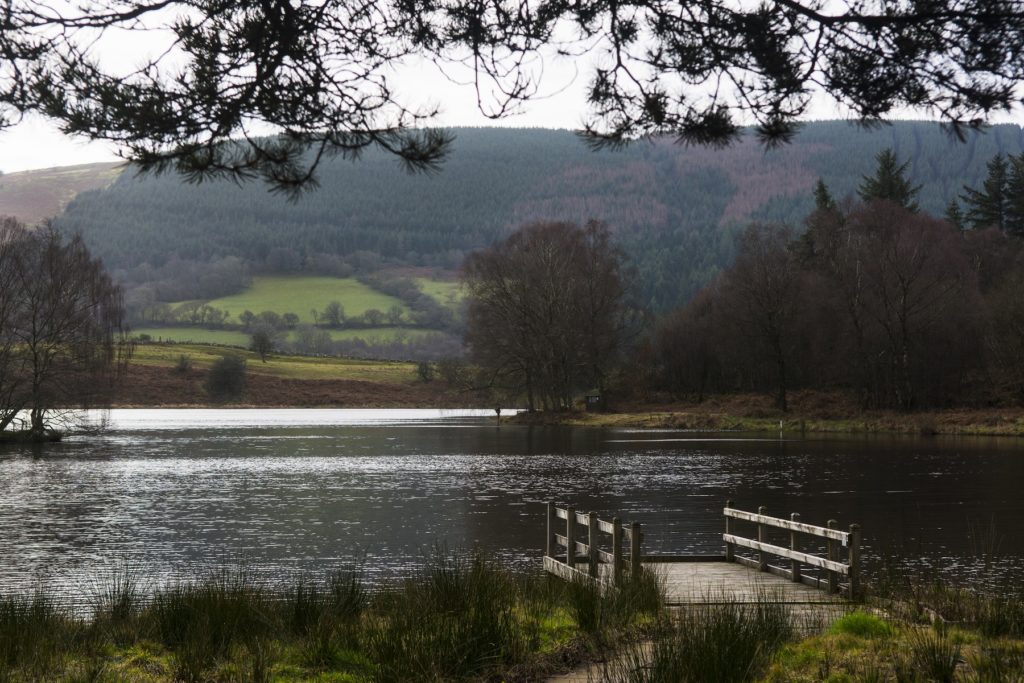
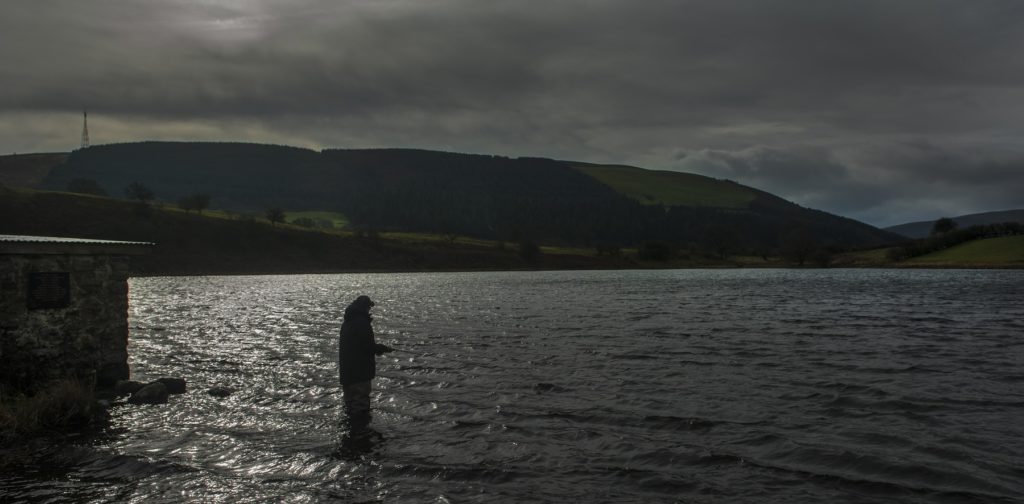
A unique and tranquil setting
A truly beautiful location, Llyn Gwyn has an air of mystery about it. The lake sits in an upland hollow, surrounded by rolling green hills, with banks clothed in sedge, grasses and bracken. A picturesque tree covered island completes the scene, as does a grove of ancient pine trees and the antique stone constructed boat house.
At 12 acres it is a nice manageable size, allowing anglers the freedom to roam and find space, without it being too large and intimidating. Being glacial in origin Llyn Gwyn is surprisingly deep, up to 50 foot in the centre, although the margins are generally shallow before shelving off, allowing for safe wading. 3 boats are available for hire and there are two fishing huts and a toilet facility on site.
A winter visit
Myself and Tim Hughes of Airflo had been meaning to visit the llyn for a while and on a mid-winter day the chance finally came. After a couple of cold, snowy and fishless weeks with ice halting sport on many fisheries it was a great chance to get out and target the resident rainbows of llyn Gwyn from the bank.
Wherever you are coming from the lake is easy to get to, being not far off the A470, the main road route through Wales.
Upon arrival at around 9.30am we found the water was ice free, with a gentle breeze and overcast conditions things looked very promising. The water temperatures however were very chilly – hovering around 4 to 5 degrees according to Tim’s thermometer. With this in mind a ‘slow and low’ approach would probably be the way forward, with the fish unlikely to be very active.
Rather than immediately reach for the full sinking fly lines, I decided to start off with a sinking tip fly line. The point fly (a black and green fritz lure) had a bead to anchor it down. On the droppers went two black crunchers (small nymphs). My idea was to slowly creep the flies back, with the point fly and sinking tip anchoring the flies down in the water. Tackle wise, I was using a 9’6 #7 fly rod, which is probably the perfect configuration for bank fishing a lake of this size.
In contrast Tim reached into his bag for an Airflo fast glass intermediate Forty Plus line, to which he attached 7lb tippet and a large white and green snake lure. Tim would try casting at distance and aggressively retrieving the fly to entice a strike. Two differing approaches – but both can work well in the winter months.
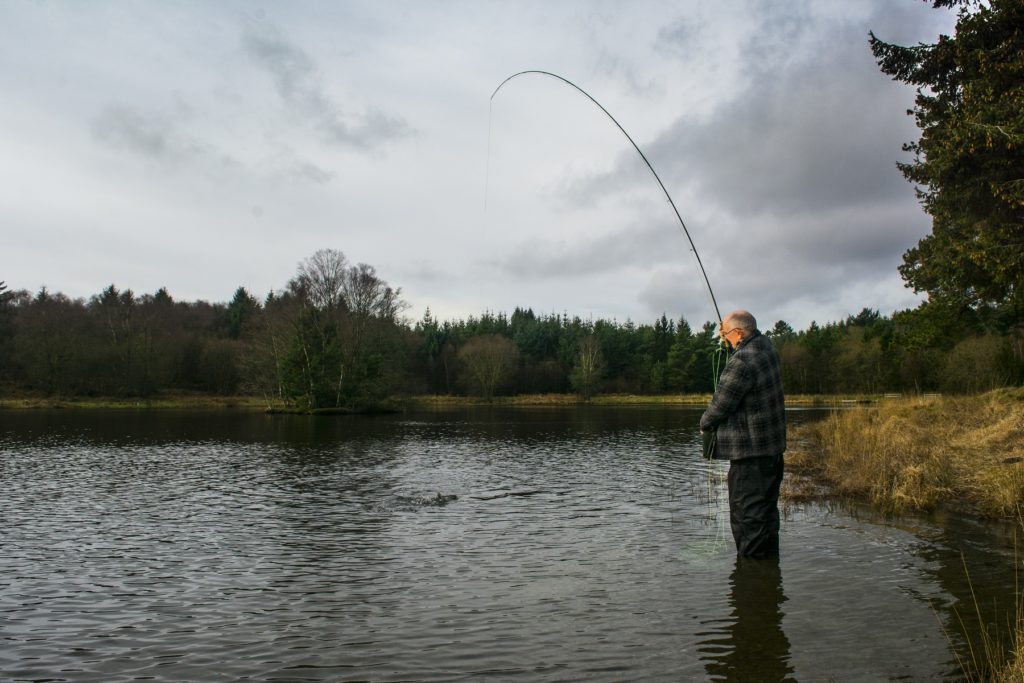
Local knowledge worth listening to
It is always worth talking to other anglers before you start fishing – in Wales you are always sure to meet friendly characters on the bank who will be happy to share information. We came across local angler Roger Lewis (who is also the club bailiff) who gave us some great tips.
It appeared the places to try were just in-line with the island, where the water depth began to shelve away to a submerged drop off. Roger explained that in winter the fish were rarely to be found in the deeper part of the lake past the boat house. To prove this point, Roger was soon into the action behind the island, catching 3 nice fish in quick succession.
This area proved to be very productive – whenever I got a nice cast of 20 yards out into the lake the takes came, and I was soon playing a very nice rainbow trout that fought well above its weight of around 3lb. The intermediate tip had proved to be the right choice; if I let the fly sink too long it would snag the rocky drop off ledge so a full sinker would have been counterproductive.
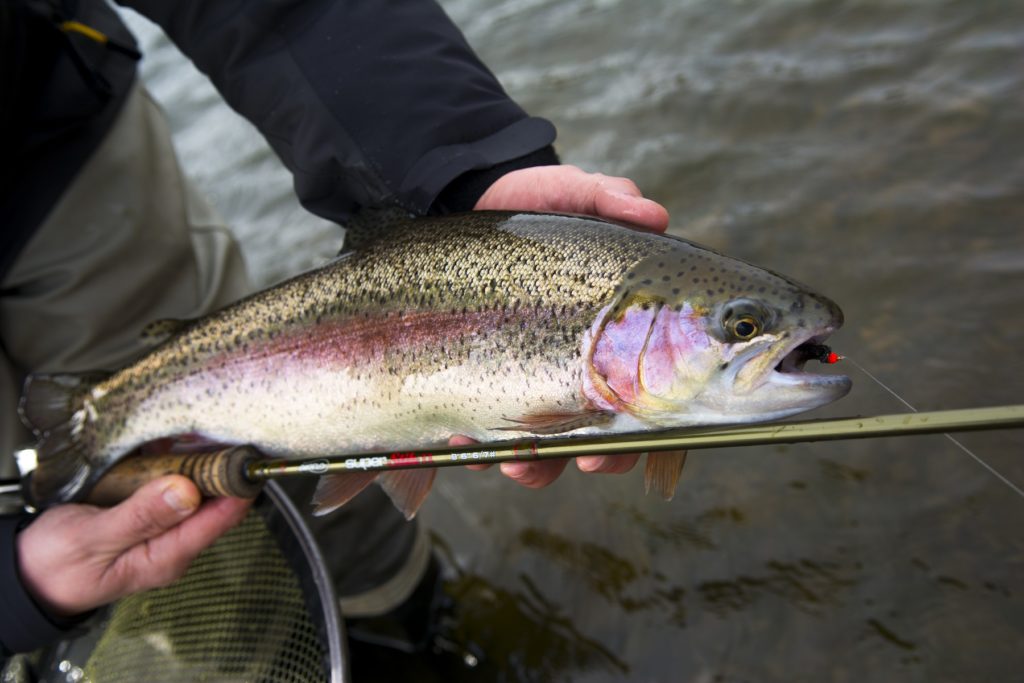
Tim had also landed his first fish on the same drop off – the green and white snake had worked on a roly-poly retrieve. After a hard half an hour Tim went back to the car to get a flask of tea to warm him up, I put out a longer line as the wind briefly lulled. On the drop, the mini tip line pulled tight and I was into a good fish that started to run off the reel. The drag was called into action instantly as this fish ran long and fast, nearly taking me into the backing. After a few minutes of playing, I felt the fish finally begin to tire and reached for the net on the bank behind me – as I did the line went sickeningly slack and it was off!
I was left wondering what sort of fish this was as I hadn’t had seen it break the surface once. I pondered why the fish had been lost – and putting aside thoughts of the ancient monks curse I checked the fly and found the hook point was blunted, no doubt from snagging up on the ledge. The moral of the story is regularly check your hook points and sharpen them if required.
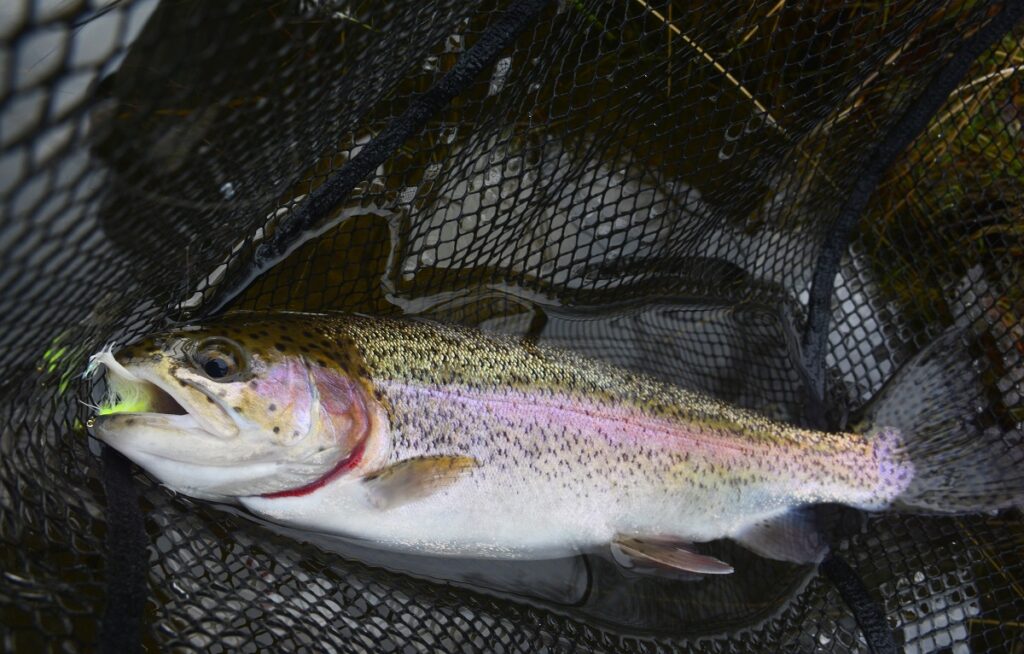
We decided to head to the other side of the island where regular visitor Rob Davies was fishing in a much more sheltered spot with a definite wind line. It was here that a sporadic hatch of buzzers was occurring, with the odd rise indicating some nice fish were in the area. Rob was into a quick succession of fine fish, landing 6 in total on spiders fished on a floating line.
Further up the bank near a fence post entering the water I connected with a good fish that had taken a black and green fritz. This one came clear of the water, revealing itself as a nice dark rainbow trout of about 4lb – which then promptly shed the hook! It seemed the curse of the monks had struck again… Another (smaller) fish took a liking to a cats whisker woolly bugger and was successfully landed. Whenever I switched lure colour I got pulls and bumps, but the fish quickly wised up and I had to change fly again to renew interest. All of the action was happening on the first few pulls of the retrieve, so I had to be alert and ready for action as soon as I started moving the flies.
As Rob vacated his hot spot and headed for home Tim jumped in and caught a rainbow right away on a buzzer pattern. The fish continued to rise occasionally, but a slight shift in the winds angle combined with the fishing pressure had pushed them out to beyond our casting range. Before finishing for the day, we returned to the windward side for a few ‘last casts’ casts, where we winkled out a couple more hard fighting rainbows.
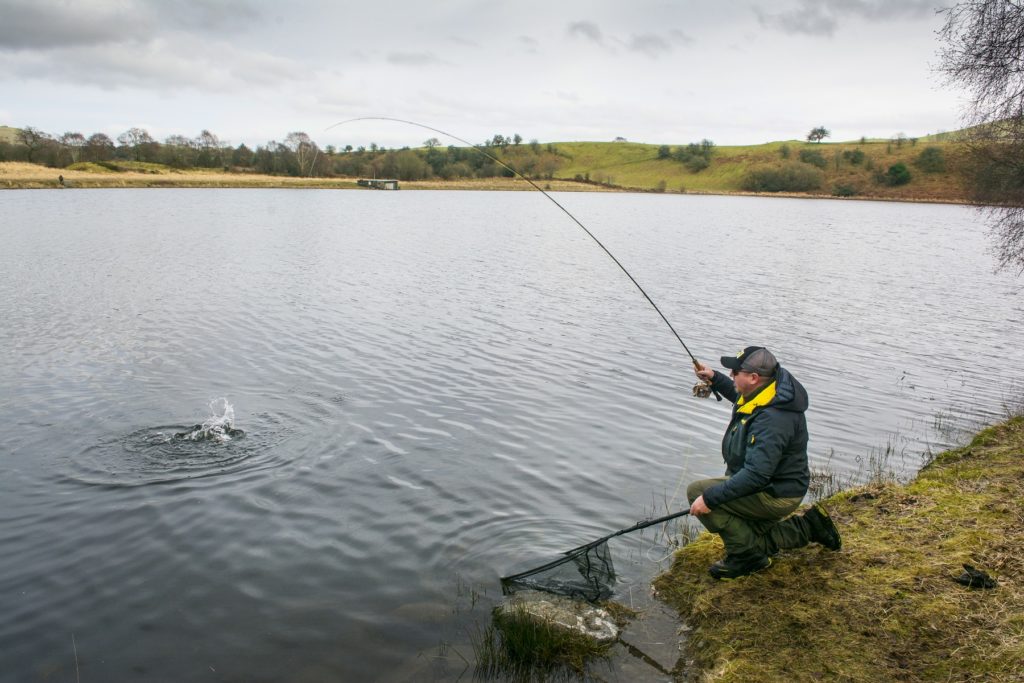
It had been a very enjoyable day out, with plenty of fish caught. The trout themselves were all in great condition, fully finned and hard fighting.
Llyn Gwyn offers something you simply don’t get with a ‘hole in the ground’ fishery – scenic views and a genuine atmosphere with a sense of history. I’d heartily recommend making the pilgrimage to llyn Gwyn if you are ever in the area.
Fishery fact file
Day Permit £20 (including catch & release)
Season permit £120
Boat day: £10
The fishery has a platform which offers access for disabled anglers.
Permits available from:
D. Powell, Newsagents, West St., Rhayader Tel: 01597 810451
Elan Valley Permits: Elan Valley Visitor Centre 10am – 5.30pm Tel: 01597 810898
Boats & Permits Llyngwyn: Nantymynach Farm, Nr. Llyngwyn Tel: 01597 810491
For more information contact Tom Jones at hafodhardware@btconnect.com or visit www.rhayaderangling.weebly.com
Words: Ceri Thomas Images: Tim Hughes
A version of this article originally appeared in Today’s Fly Fisher Magazine

Snowdonia llyn Hike VIDEO - Fishing the highest lake in Wales
Snowdonia is a magical place to go fishing. In this video we hike to 2225 feet attitude at the highest…
Read More
Coarse Fishing In Wales - VIDEO - Feeder fishing at Dolygaer Reservoir
In this video we join James Thomas of ‘Welsh Fishing Wizardry‘ and Adam Toomey of…
Read More
Reservoir bank fishing in Wales - Back end bonanza
Autumn is a fantastic time to fish our larger reservoirs for trout. Here Ceri Thomas samples the great bank fishing…
Read More



